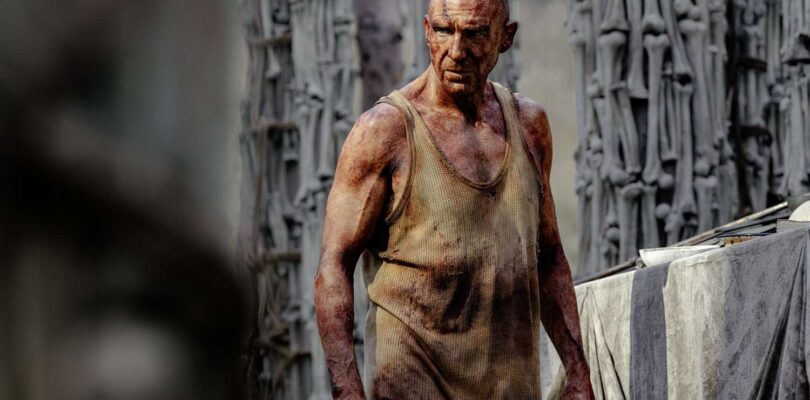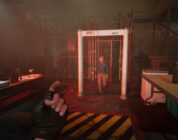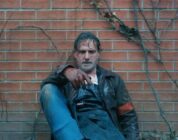Gather ye round, and I shall tell you the tale of the stout islanders off the mainland who built up a society from ruin, and the cunning boy named Spike who bravely faced demons to meet his destiny.
You may not have thought, back in 2002 when Danny Boyle’s lo-fi 28 Days Later first came out, that elements of high fantasy would ever evolve from that gritty, groundbreaking movie’s style. But give something as unpredictable as the “rage virus” enough time and there’s no telling how it will mutate.
28 Years Later, which reteams Boyle with screenwriter Alex Garland after both sidestepped to producer roles for the 2007 sequel 28 Weeks Later, shows both men working at the peak of their powers — and in absolute sicko mode. This new chapter is strange, unpredictable, gloriously revolting, darkly funny, and, when you least expect it, rather touching. It’s a full package, and one of the richest horror movies in a very long time.
Miya Mizuno/Columbia
We begin with a prologue — we’re back in the early aughts (you can tell by the cheapo digital video) and the rage virus has broken out. A group of terrorized families are together in the Scottish Highlands, trying to keep their kids calm with the Teletubbies (the one thing more terrifying than shrieking, blood-spewing bringers of death).
After one little boy escapes, we cut to 28 years later, and a small community off the coast of the British mainland. Though they lack creature comforts, there is something of a normal, even pleasant life, rooted in old English customs. A local restaurant has reverted into something of a mead hall, and the youth are taught archery. From certain angles, especially when we see the village gate and watchtower, it could be hundreds of years ago — or even something from Game of Thrones.
Our eyes and ears are Spike (Alfie Williams), a 13-year-old whose father, Jamie (Aaron Taylor-Johnson, looking a bit Aragorn-y at times), thinks the boy is ready to make his first trek to the mainland. When the tide is low, there’s a natural causeway (though if you get caught in the water, the current will drag you out to the ocean), but quick trips are essential for the village’s supplies.
But the mainland (meaning England and Scotland) has been globally quarantined, and even patrolled by European naval ships. For, you see, the rage virus still flourishes, despite being somehow contained elsewhere in the world.
The details of this are hazy, but all you need to know is that the “infected” who, we’d been told in previous films, would eventually die of starvation due to their inability to find food, have somehow found a source of nourishment.
Indeed, one of the new creatures slithering around Britain are grotesque, bloated slimeballs that suck up worms from the earth and are easily killed with a bow and arrow. More dangerous, however, are the “alphas” — variants of the fast-moving infected we already know, but now bigger, stronger, and more difficult to kill. (And also, extremely naked.)
Miya Mizuno/Columbia
Jamie and Spike’s first adventure quickly goes sideways, but the return home is even worse for Spike when he realizes that his father is not quite the honest man he’s known him to be. (A recurring theme in the series after 28 Weeks.)
Meanwhile Spike’s mother Isla (the always spectacular Jodie Comer) has grown increasingly ill. A discovery on the mainland leads Spike to learn that there may be a doctor there, so after a clever redirect, he’s able to get his mother across for one more adventure.
There are several action set pieces that follow, as well as some unexpectedly emotional (and patiently paced) scenes with more characters who enter the story. (Among them is Ralph Fiennes, who comes across at first as kooky, then ultimately very wise.)
Miya Mizuno/Columbia
Screenwriter Alex Garland (Ex Machina, Civil War) is once again deft at toggling between thrills and philosophy, and seems eager to leave ellipses in the plot, to let the mind roam and create its own lore. As in his earlier film Men, there is an almost fetishistic approach to British folklore, which Boyle playfully undercuts with Y2K-era British pop music cues.
Stylistically, Boyle throws a lot of things into a blender here, and somehow it all works. Early scenes intercut stock footage of Brittania propaganda films, which has no other motivation than to provide a vibe. Every kill of an infected slams on the brakes with a freeze frame, and the editing takes an occasionally cavalier approach to presenting sequences linearly, opting instead for a flush of sensation. Notably, much of the movie was actually shot on iPhones, a continuation of the first movie’s use of inexpensive consumer digital video.
Peter Mountain/Fox Searchlight
That technical nod, however, is one of the few commonalities between this and the original. 28 Days Later, perfectly timed as a post-9/11 product with those famous images of an abandoned city center on low-resolution stock, feels miles away from this movie’s tone. For some viewers, that may be a disappointment, but I think it represents a bold step for Boyle and Garland, especially with more movies in this world already in the pipeline.
Want more movie news? Sign up for Entertainment Weekly‘s free newsletter to get the latest trailers, celebrity interviews, film reviews, and more.
So prepare for more gruesome kills, more gross-outs, more insight into how a society might actually look a generation after an unfathomable event. These movies are clearly infectious. Grade: A-





